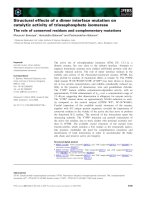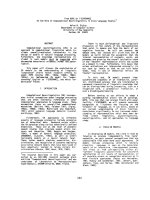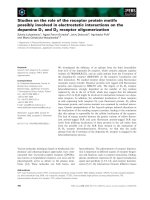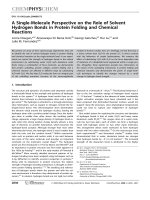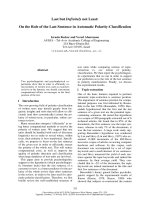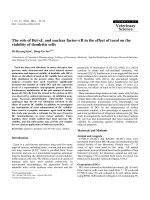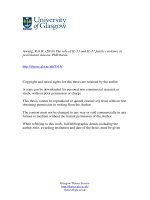Students perspectives on the role of note taking consecutive interpreting a case of english translation and interpreting majored senior students at can tho university
Bạn đang xem bản rút gọn của tài liệu. Xem và tải ngay bản đầy đủ của tài liệu tại đây (255.34 KB, 45 trang )
CAN THO UNIVERSITY
SCHOOL OF FOREIGN LANGUAGES
DEPARTMENT OF ENGLISH LANGUAGE AND CULTURE
GRADUATION THESIS
Field of study: English Translation and Interpreting
STUDENTS’ PERSPECTIVES
ON THE ROLE OF NOTE-TAKING IN CONSECUTIVE INTERPRETING: A CASE OF
ENGLISH TRANSLATION AND INTERPRETING MAJORED SENIOR STUDENTS
AT CANTHO UNIVERSITY
Supervisor:
Student’s name: Lưu Thanh Phụng Cơ
Trương Thị Ngọc Điệp
Student code: 7116843
M.Ed, senior lecturer
Class: XH11Z8A1
Course: 37
Can Tho – 04/2015
STATEMENT OF ORIGINALITY
I declare that this thesis is my original work which has not been submitted for a degree
in any other university or publish in any journal. Any reference that appeared in this
thesis has been acknowledged in the reference list.
LưuThanh Phụng Cơ
April 2015
i
ACKNOWLEDGEMENTS
Conducting this thesis is one of the most challenging work I have done as a student.
Throughout this hard process, there was time when I really wanted to give everything
up. However, I still completed it and I would like to thank the following people for
their entire support, love and care for me.
First of all, I would like to send my deepest appreciation to my supervisor, Mrs.
Truong Thi Ngoc Diep. Without her instruction and support, this thesis could never be
completed on time. I appreciate all her constructive comments and careful feedback.
My thanks go to Mr. Huynh Minh Hien for providing me many books of data analysis.
I am thankful to all the senior students majoring English Translation and Interpreting
Course 37 at Can Tho University. Their participation contributes an important part in
this thesis. If they had not attended, I could not have completed my work.
I would like to thank my close friends who gave me strength and positive
encouragement that help me over come this hard process.
Last but not least, I would like to show my dearest gratitude to my family for being
always beside and believing in me. Their endless love and encouragement helped me
over come all the difficulties that I faced during this process.
ii
TÓM LƯỢC
Ghi chú luôn được xem như là một trong những yếu tố quan trọng trong dịch đuổi.
Mục tiêu của nghiên cứu này nhằm tìm hiểu quan điểm của sinh viên về vai trò của ghi
chú trong dịch đuổi, ngoài ra nghiên cứu còn chỉ phân tích các yếu tố được sinh viên
cho là cần thiết phải trình bày trong ghi chú của mình bao gồm ghi chú những gì, cách
sử dụng hình tượng và chữ viết tắt, cách sinh viên trình bày ghi chú và ngôn ngữ được
sử dụng khi ghi chú. 76 sinh viên khóa 37 chuyên ngành Biên-Phiên dịch Anh văn đã
tham gia vào nghiên cứu. Dữ liệu định lượng được thu thập bằng bảng câu hỏi gồm 30
câu và được phân tích bằng phần mềm SPSS. Nghiên cứu đã chỉ ra sinh viên biết được
vai trò quan trọng của ghi chú trong dịch đuổi. Ngoài ra kết quả nghiên cứu cũng trình
bày được các yếu tố cơ bản xuất hiện trong ghi chú của sinh viên. Tuy nhiên, mối liên
hệ giữa ghi chú và chất lượng dịch vẫn chưa được thực hiện.
iii
ABSRACT
Note-taking has always been considered as one of the most important factors in
consecutive interpreting. The aims of this study are to investigate the students’
perspectives on the role of note-taking in consecutive interpreting. Moreover, the study
also analyzes what students perceived to be presented on their notes including what
students take notes, how did they use abbreviations and symbols, how they arranged
their notes and the language they used in notes. The participants in this study were 76
students from English Translation and Interpreting Course 37 at Can Tho University.
Quantitative data is collected from a questionnaire consisting of 30 Likert-scale items.
The software used to analyze the data is Statistic Package for Social Science Software.
The study finds out that student aware of the importance role of note-taking in
consecutive interpreting. This study also presents the elements that students thought
they should present in their notes. However, the relation between notes and the output
interpretation has not been studied.
iv
LIST OF TABLES AND FIGURES
Table 1. Demographic characteristics of participants……………………………..23
Table 2. The reliability of the questionnaire……………………………………....26
Table 3. Summary of questionnaire…………………………………………….....26
Figure 1. Response to the role of note-taking……………………………………...27
Figure 2. Response to what students take notes…………………………………....28
Figure 3. Response to when students take notes…………………………………...29
Figure 4. Response to the language used in notes……………………………….....30
Figure 5. Response to note arrangement…………………………………………...30
Figure 6. Response to how students take notes…………………………………….31
v
TABLE OF CONTENT
STATEMENT OF ORIGINALITY ............................................................................... i
ACKNOWLEDGEMENTS........................................................................................... ii
TÓM LƯỢC.................................................................................................................. iii
ABSRACT ..................................................................................................................... iv
LIST OF TABLES AND FIGURES ............................................................................. v
TABLE OF CONTENT ................................................................................................ vi
CHAPTER 1: INTRODUCTION ................................................................................. 1
1.1. Rationale................................................................................................................... 1
1.2. Research Objectives and Significance ....................................................................... 3
1.3. Thesis organization ................................................................................................... 3
CHAPTER 2: LITERATURE REVIEW ..................................................................... 5
2.1. Consecutive interpreting ........................................................................................... 5
2.2. Note-taking in Consecutive Interpreting .................................................................... 6
2.2.1. What to note........................................................................................................... 7
2.2.1.1. Main ideas........................................................................................................... 7
2.2.1.2. Links................................................................................................................ 7
2.2.1.3. Proper names ................................................................................................... 8
2.2.1.4. Verb tenses ...................................................................................................... 8
2.2.2. When to note .......................................................................................................... 9
2.2.3. What language to note? .......................................................................................... 9
2.2.4. How to note ......................................................................................................... 10
2.2.4.1. Abbreviation .................................................................................................. 10
2.2.4.2. Negation and Emphasis.................................................................................. 11
2.2.4.3. Symbols ......................................................................................................... 12
vi
2.2.5. Note Arrangement ................................................................................................ 14
2.2.5.1. Verticality ...................................................................................................... 14
2.2.5.1.1. Stacking ...................................................................................................... 14
2.3. Recent studies related to Note taking in Consecutive Interpreting ........................... 16
2.4. Research Questions ................................................................................................. 19
CHAPTER 3: METHODOLOGY .............................................................................. 20
3.1. Research design ...................................................................................................... 20
3.2. Participants ............................................................................................................. 21
3.3. Instrument ............................................................................................................... 21
3.4. Data collection ........................................................................................................ 22
CHAPTER 4: RESULT, DISCUSSION AND CONCLUSION................................. 23
4.1. Reliability of the questionnaire ............................................................................... 23
4.2. Students’ perspective on the role of note-taking in consecutive interpreting ............ 24
4.3. How students describe their notes ........................................................................... 25
4.4. Conclusion .............................................................................................................. 27
CHAPTER 5: LIMITATIONS AND DIRECTIONS FOR FUTHER RESEARCH 29
5.1. Limitations.............................................................................................................. 29
5.2. Direction for further research .................................................................................. 29
REFERENCE .............................................................................................................. 31
APPENDIX A .............................................................................................................. 33
APPENDIX B- SPSS DATA ........................................................................................ 36
vii
CHAPTER 1: INTRODUCTION
This chapter includes (1) rationale of this thesis, (2) research objectives and (3) thesis
organization.
1.1. Rationale
Interpreting is a process in which the interpreters listen to the source text then analyze
and render it into another language. Especially in consecutive interpreting, the
interpreters are required to retain a great amount of information in their mind
(Fangquin, 2004). Therefore, a good memory is an essential element for the
interpreters. However, the capacity of human mind is limited (Zhang, 2012) and the
interpreters usually deal with short-term memory. Short-term memory is able to retain
the information for just a brief period of time (Kriston, 2012). According to Smith (as
cited in Thai, 2006) the duration of short-term memory is limited because people can
only remember six or seven items when they give all their attention to them.
Furthermore, in consecutive interpreting, the speech of speaker could last from 5, 10
and even more than 15 minutes. Hence, it is impossible for the interpreters to
remember the content of the speech without noting any information down and the
action of noting down key points of information is called note-taking.
Note-taking has been always considered as one important element in consecutive
interpreting. In facts, the importance of note-taking has been presented in many
researchers’ work. Furthermore, note-taking is a skill that always included in the
course of interpreting. In particular, in the latest curriculum for English Translation
and Interpreting at Can Tho University, the subjects namely Interpreting 1 and
Interpreting 2 focus mainly on basic consecutive interpreting and Interpreting 3, 4
focus on advanced Interpreting.
The important role of note-taking is examined when Pham (2006) from Ha Noi
conducts the study with the participation of 120 seniors. The result of his study show
that nearly 50% of participants think that note-taking is the most important element in
consecutive interpreting.
1
Another similar research is conducted by Zhang (2012) in China. She also investigates
the importance of note-taking. However, her finding is different with the finding of
Pham (2006) as most respondents in her study think that note-taking is just a
supportive helper for the interpreters.
With the specific focus on the language used in notes, two research are conducted by
Dam (2004) in Australia and Liu (2012) in China. After analyzing the notes of
participants Dam (2004) conclude that students prefer to take notes in target language
while Liu (2012) state that the participants in her research take notes mainly in source
language.
Many handbooks of note-taking provided by professional interpreters as Rozan (2002),
Nolan (2005), Seleskovitch (1995) and Gillies (2005) which guide and train students
to take a good note. However, my experience as an English Translation and
Interpreting-majored student shows that although these authors state that interpreters’
notes are personalized in character and only the interpreters can read their own notes,
not all students know how to take good and appropriate notes as the fact that they
rarely approach these handbooks and the limitation in interpreting courses do not
provide students a clearest guidance or practice.
Some research have been done in the field of note-taking. However, few studies have
been conducted in Viet Nam, especially in Can Tho city. Therefore, with an
understanding of the importance of note-taking as well as aiming to provide an overall
looks of note-taking in consecutive interpreting, the purpose of this current paper is to
investigate the students’ perspective on the role of note-taking in consecutive
interpreting. Furthermore, this study also analyzes how students take notes. The study
was particularly conducted with the participation of English Translation and
Interpreting seniors at Can Tho University. Hopefully, the thesis can contribute a great
part for the training of note-taking in consecutive interpreting as well as become a
useful material for those who interested.
2
1.1.Research Objectives and Significance
The research focuses on two objectives. The first objective tends to study the
perspective of English Translating and Interpreting seniors on the role of note-taking
in consecutive interpreting. The second objective is to analyze how students take
notes. In particular, it aims at examining the elements that students think they will
present on their notes.
The result of this study can be used as a useful reference to improve the Interpretation
courses in the curriculum. In addition, the key factors in this thesis are the important
role of note-taking in consecutive interpreting. Therefore, this thesis is a supportive
material for students who will become interpreters in the future.
1.3. Thesis organization
This thesis comprises five chapters, including (1) Introduction, (2) Literature Review,
(3) Methodology, (4) Result, Conclusion and Discussion and (5) Limitations,
Implications and Recommendations.
Chapter 1 discusses 3 main parts. Rationale aims at giving background knowledge of
the current topic. The second part is research objectives and significance. This part
mentions the goals of this study and the last part is thesis organization which presents
how this thesis is organized.
Chapter 2 states the key terms appearing in this research. The content is divided into 2
main parts, including consecutive and note-taking. Some summary of related studies
are also presented in this part. Besides, Research questions also include in this part as
the last part.
Chapter 3 includes research design, participants and the criteria for choosing them.
Material, instrument and procedures of collecting data are mentioned as the following
parts in this chapter.
3
Chapter 4 presents result in this study. Besides, conclusion and recommendation are
also included in this chapter.
Chapter 5 has 2 main parts. The first part is limitations which presents some
drawbacks of this thesis. Directions for further research are mentioned as the last part.
4
CHAPTER 2: LITERATURE REVIEW
This chapter presents (1) consecutive interpreting, (2) note-taking in consecutive
interpreting, (3) research questions and (4) research hypotheses.
2.1. Consecutive interpreting
There are two main modes of interpreting. The first mode namely simultaneous
interpreting usually applies in big conferences, seminars or international events. The
interpreter listens to the speech and reproduces the message from the source language
to the target language at the same time as the speaker delivers their source text (Lu,
2012). The interpreter sits in a booth and completes his or her work with the help of
headphone and microphone.
The second mode is consecutive interpreting which is a mean to orally convey the
messages from the source language to the target language. In consecutive interpreting,
the interpreter listens to the whole speech or at least the important part and then
reproduces the speech sometimes with the help of note-taking (Jones, 2002).The
interpreter needs to make sure that the output interpretation is as close to the source
text as possible in terms of content, delivery and style (Strani, 2015).
Unlike simultaneous interpreting, inconsecutive interpreting, no electronic equipment
is needed and normally only one interpreter is needed to do the job (Vojnarova,
2012).Furthermore, although in consecutive interpreting, the interpreters rely mainly
on memory, a good note-taking is an essential aid to help them complete their job
more completely (Nolan, 2005).
Consecutive interpreting can be applied in various circumstances which require
personal interaction such as press conferences, interviews, meeting or any individual
situations. One significant advantage of consecutive interpreting is that it gives the
interpreter more time to think and take notes in order to interpret more accurately (Lu,
2012).
5
Consecutive interpreting is always considered as the starting point in interpreting
training at the tertiary education for the reason that during training consecutive
interpreting, the students learn and improve the general interpreting techniques that
will also support as the basis for simultaneous interpreting (Yunida, 2009).
In conclusion, consecutive interpreting is a process in which the interpreter has to
actively listen to the speaker, take notes and orally translate it into the target language.
A good memory is the most important element for an interpreter; however, without the
help of note-taking, their work can never do completely.
2.2. Note-taking in Consecutive Interpreting
In the interpreting process, the interpreter usually deals with short-term memory.
Short- term memory is the part of memory which stores a limited amount of
information for a limited amount of time, roughly 15-30 seconds (Zhong, 2001).
Moreover, the speech of the speaker could last 15, 20 and even 30 minutes. Therefore,
it is impossible for the interpreter to reproduce the speech of this length without
putting a few things down on the paper (Seleskovitch & Lederer, 1995). Thus, the
purpose of using note-taking is to assist the interpreter’s memory (Sakamoto, 2011).
Note-taking is one of the crucial operations involved in the process of consecutive
interpreting (Sladovnik, 2014). There are three basic stages in consecutive interpreting
including understanding, analyzing and re-expressing (Jones, 2002), and note-taking is
closely related to these stages as the interpreter needs to understand the speech, pick
up the main ideas to take notes and base on the notes to re-express the speech in the
target language.
In addition, the interpreter’s notes are especially individual in character (Lu, 2012).
Many principles and rules are set by many authors as well as professional interpreters.
The interpreters can follow these principles to begin as beginning interpreters but they
need to create and develop their own method of taking notes in order to make their
notes become an effective tool in consecutive interpreting.
6
Furthermore, when taking notes, the interpreter does not jot down everything the
speaker says and the interpreter’s notes are not the same as the lecture notes of
students which they write down in relatively complete sentences so that they can
easily-read the notes later (Lu, 2012, Seleskovitch & Lederer, 1995).
In conclusion, note-taking plays an important role in the consecutive interpreting
process because notes help the interpreters improve memory efficiency and notes are
an essential aid that help the interpreters re-produce a better interpreting output.
2.2.1. What to note
2.2.1.1. Main ideas
Jones (2002), Seleskovitch & Lederer (1995), Rozan (2002) stated that main ideas are
the first things that should be noted. The main ideas and the links between them in
notes can be considered as outline of the speech (Jones, 2002). It is necessary for the
interpreter to have the ability to identify, select, retain the important ideas and omit
anything which is irrelevant to the understanding of the original speech, and always
keep reliability of the original text by noting down the main ideas in notes (Listiani,
2010).
An interpreter must not try to write down everything the speaker says because a
hundred words may contain only one idea, while one word may imply several ideas
(Nolan, 2005). In facts, when an interpreter writes down a word, she or he may get
confuse when re-read it because she or he cannot get the appropriate meaning of this
word in specific context. Therefore, it is very dangerous as it may lead the interpreter
to confusing situations. Having the same point of view, Garetson (as cited in Nolan,
2005) indicated that although it is very hard to remember a large number of words, it is
not difficult to remember many ideas.
2.2.1.2. Links
A speech is just a meaningless of ideas if it does not consist of the links Gillies (as
cited in Sladovnik, 2014). In addition, the first key to understand a speech is the
7
identification of the main ideas and the second is the links between those ideas (Jones,
2002).
Abbreviations of linking words are also very important. Rozan (2002) recommended
some simple key words to note the links:
As, why
: to mean because, as, for this reason
Tho
: Although, despite
But
: However, nevertheless
If
: Supposing
As to
: as regards, regarding, concerning
Tfe
: therefore, in conclusion, we can conclude that
The links should be noted logically as their function is to connect the main ideas. If the
interpreters do not arrange it logically, the notes will become too mess to read back.
2.2.1.3. Proper names
Although main ideas should be the first thing to be noted, proper names should also be
jotted down. It is necessary for the interpreter to note down the proper name when they
are not familiar with it (Jones, 2002).
Proper names are not only name of people; it can be geographical names, name of
organizations or companies, etc. When the interpreters do not know the proper names
which the speaker says, then they should ignore the orthography and write down the
phonetically as closely as possible to what they believe they have heard. Seleskovith &
Lederer (1995) and Jones (2002) stated that unfamiliar names are very difficult to
catch up and retain in the interpreter’s mind. Therefore, the interpreters should note
down any unusual name as phonetically as possible.
2.2.1.4. Verb tenses
Verb tense should be presented in the notes (Jones, 2002).The three tenses that are
most important are the present, the past and the future. The interpreters can use “-ed”
to imply the past and “-ll” to imply the future. If the interpreters’ native language is
8
not English, they can borrow English suffixes or other suffixes that use commonly in
their mother tongue.
In conclusion, whenever taking notes the interpreters must concentrate on the ideas
and how this can be note clearly and simply. Besides ideas, proper names and verb
tense should also be noted.
2.2.2. When to note
Herbert (as cited in Al-Zahran, 2007) stated that the interpreters should start to take
notes right after the speaker start delivering his or her speech because in some
situations the interpreters do not know how long the speech will last and what they
might look like a few words may unexpectedly end up as a very long speech.
In contrast, Fleming (2014) argued that the interpreters should not write anything until
they have done the three stages namely listening, understanding and analyzing. In
other words, he suggested that the interpreters should only take notes when they
understand the meaning of a message or at least a sentence.
2.2.3. What language to note?
The interpreters should write the notes in the target language as much as possible
(Nolan 2005). Having the same idea, Lederer and Seleskovitch (1995) explained that
the purpose of noting word in the target language is to retain any ideas which cannot
be noted by symbols.
However, according to Alexieva (as cited in Al-Zahran, 2007), there are two main
reasons why the interpreters should take notes in source language. Firstly, noting in
target language means adding interlingual transfer to listening, note-taking a memory
operation and thus, this process is obviously complicated. Secondly, the reliability of
interlingual transfers in the absence of the following context is questioned since
decision taken may not warranted by what comes next, which may lead to incorrect
notes. In contrast, Matyssek (as cited in Dam, 2004) pointed out that the interpreter’s
native tongue is also preferred.
9
With the neutral point of view, Jones (2002) stated that the interpreters should not
worry so much about the question of the source or the target language to notes. It is
advisable to choose the one that interpreters are familiar with. Otherwise, the
interpreters may be very confused by their own notes.
In short, the interpreters should choose the language that comes to their mind as the
easiest or most appropriate one (Ma, 2013). It can be either source language or target
language depending on the interpreters. The aim of the language’s choice is to help the
interpreters read back the notes easily.
2.2.4. How to note
In order to have effective notes, the most important thing the interpreter must do is
select what to notes. However, how to note is also very important. Conspicuously,
notes that are clear and logical structured help the interpreters avoid all confusion
when reading back notes. Moreover, the interpreters have to take notes as quickly as
possible since they do not have much of time. Therefore, using abbreviations and
symbols is the best way for them to save time and take notes more effectively.
2.2.4.1. Abbreviations
Abbreviations can help the interpreters in saving time spent on other activities in the
process of interpreting. If a word consists more than 5 letters, the interpreters should
use the abbreviated form of it when taking notes (Rozan, 2002). In order to help the
interpreters understand immediately when reading back notes, these abbreviations
must be definitive and unambiguous because under time pressure the interpreters have
no chance to reconsider the meaning of abbreviations.
Rozan (2002) suggested some principles and rules for the use of abbreviations. The
following suggestions about creating abbreviations are based on the truth that the
fewer strokes are written, the more time the interpreter can save.
10
1/ Note down what is heard: The interpreter can write a word by recording its sound
only.
Example: school-skull; you-u; tonight-2nite etc
2/ Drop medial vowels:
Example: because-bc; altitude-alt; people-plp; please-pls; address-add etc.
3/ Write initial and final vowels:
Example: altitude-alt; student-stdt; thanks-tks; limited-ltd; etc
Abbreviations of common international organizations should be remembered by the
interpreters. The interpreters must have some background knowledge about these
abbreviations. The following are some abbreviated form of common organizations.
The list of abbreviations below is recognized worldwide.
World Bank
WB
European Union
EU
Asian Development Bank
ADB
World Trade Organization
WTO
International Monetary Fund
IMF
United Nations Children’s Fund
UNICEF
North Atlantic Treaty organization
NATO
Association of Southeast Asia Nations
ASEAN
2.2.4.2. Negation and Emphasis
2.2.4.2.1. Negation
Herbert (as cited in Jones, 2002) said that negation and emphasis should be noted
clearly and unambiguous. The interpreter can use the line crossing the word or a
symbol to imply negation.
Example: Good = agree, something happen appropriately, etc.
Good = Disagree, something wrong happens, etc.
11
Writing “no” in front of the word can also be considered as a way to negate a word.
Example:
S.O.S = emergency situation
No S.O.S = nothing serious or no emergency situation happens
2.2.4.2.2. Emphasis
The interpreter can underline a word to emphasize it. The line must be twice if an
interpreter dealing with a highest degree (Rozan, 2002).
Example: comfortable
:
comf
Very comfortable
:
comf
Extremely comfortable
:
comf
In conclusion, using abbreviations helps the interpreters save a lot of time as they use a
few abbreviations to imply many ideas. These abbreviations must be frequently
practiced and remembered by the interpreters in order to avoid misunderstanding when
applying them in note-taking. Otherwise, they can lead the interpreters in a hard and
confusing situation.
2.2.4.3. Symbols
A symbol can be an object, picture, written word, sound, or particular mark that
represents something else by association, resemblance, or convention. It is easier to
note down a symbol than a word. Moreover, writing symbols helps the interpreter
reduce the amount of time in comparison with written word (Pham, 2006).
Having the same rule as abbreviations firstly symbols need to preparing in advance.
Any symbol unprepared in the middle of interpretation could put the interpreters into a
hard situation which results in the bad interpreting output. Secondly, the most
important rule for the interpreters to notice is that they always use a symbol to mean
only one thing in a given text (Nolan, 2005).
Gillies (as cited in Sladovnik, 2014) presented some basic guidelines on how symbols
should be like. First, it must be clear and unambiguous. The symbols need to be simple
12
to draw. In addition, symbols need to be consistent and organic, which means that one
symbol should be the starting point for many other symbols. Finally, they must mean
something to the interpreters. The interpreters must use the symbols that are familiar to
them and the meaning of symbols must be created by the interpreter himself only.
Following this rule, the interpreter can avoid mistakenly from the meaning of the
symbols he or she uses. The examples below are some symbol examples taken from
the book “7 principles of Note Taking” by Rozan (2002). In his book, he classifies
symbols into 3 categories including the symbols of expression, the symbols of motion,
and the symbols of correspondence. Besides the three main categories of symbols, he
also provides the symbols of things which could be very useful for the interpreters.
The arrow for increase
Speech
:
The arrow for decrease
Thought
“
Relation
Discussion
Approval
∎
Equivalence
=
OK
Difference
≠
Framing
[]
The arrow for direction
Some symbols that useful for the interpreter:
Country, nation. National
Labour, work, action
International, aboard
X
Issue, problem
Global, universal,world
w
W
13
?
Trade, trade relation
Ms
Members,participants
Tr
Using abbreviations and symbols helps the interpreters save time and take notes more
accurately. However, Orlando (2010) stated that the system of notes developed by
each interpreter is surely personal, even if symbols and ways of noting ideas and links
can be borrowed from existing modeled system, students should create and use their
own abbreviations and symbols in order to have the best notes. They can remember the
symbols and abbreviations by using them frequently and consistently.
2.2.5. Note Arrangement
2.2.5.1. Verticality
When the interpreter takes notes from top to bottom rather than left to right, it is called
verticality. Rozan (2002) explained that the purpose of using verticality is to help the
interpreters group the ideas logically, allowing a complete and immediate synthesis
when they read back the notes. In addition, verticality helps the interpreter break the
sense units for easy digestion (Ma, 2013). The interpreters can use stacking or brackets
when they note vertically.
2.2.5.1.1. Stacking
Stacking consists of placing different elements of the text above or below one another
For example the interpreters could note the sentence “The topic on increasing fee is
very hot” as:
Topic hot
fee
2.2.5.1.2. Using Brackets
Bracket is considered as an important part of the verticality system. In the speech there
will consist of certain elements that are used to clarify and idea or to highlight a
particular point. Then, these ideas should be put in brackets (Rozan, 2002).
14
Example:
“Using abbreviation to note is very important,
it helps the interpreter save time and note quickly”
Use Abre impt
(save time+quick)
Having the same point of view, Macek (as cited in Sladovnik, 2009) also
recommended that the less important information should be noted in the brackets.
2.2.5.2. Shift
Rozan (2002, p22) stated that “shift means writing notes in the lace on a lower line
where they would have appeared had the text on the line above been repeated”. It
means that the interpreters use shift to give his or her note a vertical layout. Therefore,
it is easier for them to read back their note.
The example below is taken from Rozan (2002, p21-22) which is probably best to
demonstrate “Shift” in note-taking:
“Over the course 1954, prices rose, although not to the same extent as income, thus the
population’s net income increased”
54,prices
but
no = income
so
There are three most important elements in a sentence including subject, verb, objects
they contain nearly all the meaning of the sentence. Therefore, they should be clearly
represented in the notes. Jones (2002) stated that these three elements should be
arranged diagonally, from left to right and from top to the bottom of the page.
Moreover, the three elements should be allocated in the same position in any given
section of the notes. The purpose of diagonal layout is to reflect the structure of a
speech so that the interpreter can easily reproduce the speech when they re-read the
notes. Jones (2002) described diagonal layout as:
15
SUBJECT
VERB
OBJECT
Example: A short passage below was taken from the website “Short reading
comprehension passages”. The content of this passage can be noted as the following
structure S+V+O
“Dolphins are regarded as the friendliest creatures in the sea and the stories of them
helping drowning sailors have been common since Roman time”
Dolp 1stfriendly creature -in the c
Story of Dolp common- Roman time
2.3. Recent studies related to Note taking in Consecutive Interpreting
In China, Liu (2012) investigated the characteristic of the notes taken by students to
find out the role of note-taking in students’ interpreting process and the language they
mainly used in notes. The experiment was conducted in the language lab and the
participants are fifty-eight junior students, they took part in the experiment in three
different days within a week. They were asked to translate four paragraphs then
recorded their interpretation on the computer. She also collected the notes to
investigate what students jot down during their interpretation process. She drew to the
conclusion that students, whether competent or less competent take notes mainly in the
source language. The average number of words and signs in the notes was about onethird of the whole text to be interrelated. The results of her study also showed that
students thought that note-taking play an important role in consecutive interpreting
process. Finally, she suggested that students should be trained to rely on memory
rather than notes.
16
Having the same aim of research, in Vietnam, Pham (2006) conducted the study to
explore how interpreting students think about the skill of note-taking in consecutive
interpreting. A group of 120 senior students attended in this research. The results of
this research led to the conclusion that taking notes in consecutive interpreting
involves various techniques that are quite easily achieve if students study hard and
have regularly practice and nearly 50% of respondents thought that note-taking is the
most important element in consecutive interpreting.
In China, Zhang (2012) examined and analyzed cognition and psychology to find out
the role of note-taking in consecutive interpreting. In her research, she use Gille’s
effort model on consecutive interpreting as basic theory framework, and the result
found that note-taking is just a necessary assistant in consecutive interpreting. The
result also stated that students are coached to smartly choose what to be noted down.
One more study from China was conducted by Lu (2012), in her research, she
presented seven basic principles from author Rozan and some practical hints from
various professional interpreters in order to help those who want to be the interpreters
in future develop good skills in note-taking. The study also gives the conclusion that a
note-taking has both negative and positive effect for the interpreters. Finally, she
strongly impressed that note-taking is a personal system and only practice hard can the
interpreters have good skills in note-taking.
Machova (2009) from Comenius University conducted a research to find out the
relationship between the number of publications on note-taking and the form of notes
that the interpreters takes in consecutive interpreting. 20 notes samples collected from
random Slovak interpreters were used as material. The 20 interpreters needed to
provide the information on which theoretical books on note-taking they were familiar
with. As the result, the more handbooks of note taking the interpreters read the more
they use it in their notes effectively. Furthermore, this study also showed that those
who have read more than one book use only a few symbols on average.
17
